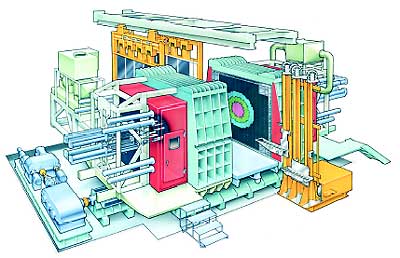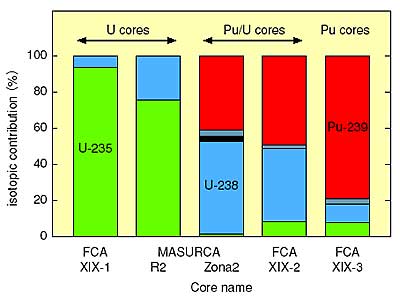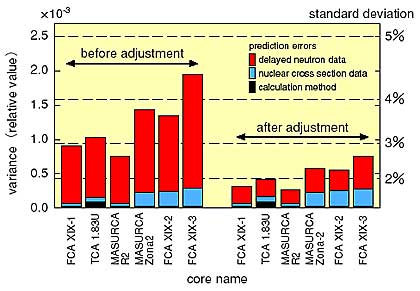| Fission neutrons are classified into two groups, (1) the neutrons that
appear essentially instantaneously (within 10-14 s) of the fission event and (2)
the neutrons that appear with an appreciable time delay from the subsequent
decay of radioactive fission products. The former are referred to as prompt
neutrons and the latter are called delayed neutrons. Although the fraction
of delayed neutrons to fission neutrons is very small (less than 1%),
the delayed neutrons are vital for effective control of the fission chain reaction
in a nuclear reactor. From the standpoint of nuclear reactor control,
it is important to predict accurately the effective delayed neutron fraction,
betaeff, especially in innovative light water reactors and fast reactors where a
mixture of uranium and plutonium is used as nuclear fuel. To improve the prediction
accuracy of betaeff, a program of benchmark experiments was conducted as an international
collaboration. It was comprised of experiments at the FCA (Fast Critical
Assembly) facility of JAERI (Fig. 2-3) and the MASURCA facility of CEA,
France. In these experiments, several core configurations were selected taking into
consideration the systematic change of the nuclide contribution from 235U,
238U, and 239Pu to betaeff, as shown in Fig. 2-4. Six organizations from
five countries participated in the experiments. Each participant used his own
betaeff measurement technique, and the measured results were compared with each
other. The individual results have been combined to provide a recommended
value having a high accuracy for each core type. Through the analyses of these
experiments, delayed neutron data were evaluated and adjusted using current
calculation methods. The results show prediction accuracy for betaeff values
improved from 3-5% to 2-3%, as seen in Fig. 2-5. These results have
been included in the delayed neutron data of the latest evaluated nuclear data
library, JENDL-3.3. |


